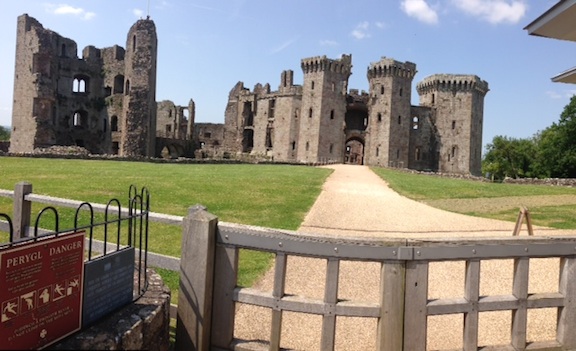Above: Tintern Abbey
By Marcia Forbes, PhD
CJ Contributor
Road Trip to Wales
We packed biscuits, sandwiches, crisps (we call them chips in Jamaica but the Brits prefer crisps), fruits, a variety of drinks and filled the car tank with petrol. We were ready, my husband, cousin and me, off to the Brecon Beacons Mountain Range in Wales hundreds of miles away. Road trips can be great fun and the three of us were excited.
Sat Nav Takes Control
The postal code/postcode (I think that’s what they call it in the UK, not Zip Code as in the US) for the hotel at which we’d be staying was entered in the Sat Nav (Satellite Navigation) system and off we drove.
Although my cousin Elaine knew how to get to our first highway, she preferred to be guided by the Sat Nav just in case the machine could identify a shorter or less congested route. I’d seen a similar behaviour among my other relatives in the UK. Their Sat Nav was everything once we headed out to an unfamiliar location. Many years ago on my visits it used to be paper maps spread across laps.
The smart machine would detect the best route for that particular time of day and lovingly guide us to our final destination. That’s what they all seemed to think. I’m not as trusting of the Sat Nav having many times experienced the US version called GPS (Global Positioning Sytem). In the middle of nowhere in Florida or elsewhere, our GPS would announce, “you are now at your destination,” to wit, I’d reply, “no we’re not!”
All the Sat Navs/GPSs I’ve experienced carry a soothingly confident female voice. Rightly so since men are famous for refusing to ask directions and constantly get lost. In Germany, however, BMW had to recall its female-voiced GPS. German men refused to take directions from a female voice we are told by Clifford Nass, a Stanford University Professor whose work in communication and computers I greatly admire.
Above: Raglan Castle
AA to the Rescue
Let me return to the road trip. Being blind my husband was not driving us to Wales. Years ago when he first went blind, he did drive but that a whole other story. Anyway, he interrogated Elaine as to the roadworthiness of her brand-new second-hand car. Did she check the pressure of all tyres? What about the spare tyre? To his distress, not only had she not checked the tyres but she didn’t even know where the spare tyre was “hidden.”
Elaine was a true believer in the AA. No, not Alcoholics Anonymous! The Automobile Association offers roadside assistance across the UK and many other countries. She confidently announced that AA would be there to our rescue should we have any problems at all with the car. She extolled their virtue of being prompt and reliable. Similar to my lack of faith in the Sat Nav, I wasn’t confident about the promptness of AA. Normally a 15 minute wait seems like an eternity to me.
The Welsh countryside was beautiful. There was Raglan Castle (Gastell Rhaglan in Welsh) imposing its beauty on the hillside. It drew us in and we succumbed. The road was unpaved but it was just a short drive. Coming back down the car seemed ‘rattley’. On the main road the ‘rattley’ feel got more pronounced. Then metal hit road and we knew the tyre was gone.
Elaine pulled to the soft-shoulder. AA did indeed come to our rescue a quick hour and fifteen minutes later. Jeff was outstanding. Not only was the tyre in shreds but the spare, hidden under the car, was totally underinflated. He sorted it all and piloted us to Kwik Fit some miles away for two new wheels.
Undaunted by the now almost 4 hour delay in our journey back home, Elaine insisted on the most scenic route. Jeff kindly directed us. Minus Sat Nav and entirely guided by Jeff’s instructions, we experienced sixteen miles of the most stunning sights of Wales – Wyevale and its fabulous Tintern Abbey, a breathtaking shell of its former Cistercian monastic beauty, Chepstow Racetrack, miles of the quaintest countryside and the impressive Severn Bridge.
Getting Lost via Sat Nav
Over the Bridge we again hooked up the Sat Nav by entering the postcode for home. My cousin Elaine is an awesome, trusting woman. Her Sat Nav is seven years old and has only been reprogrammed once, despite the recommended once every three years reprogramming. At times Sat Nav refused to talk to us. En route to Monmouth, she had us going around in circles. After the third time around we decided to ignore her and rely on brain power instead.
A charming feature of our road trip was the number of times we got lost. My cousin was utterly unperturbed. Sat Nav worked overtime to reprogramme our route. Each time we got lost we saw more of the beauty of England or Wales and savoured new experiences. It was a joyous time.
While awaiting the AA we saw homing pigeons being released. About thirty birds took off from the back of a car and flew around in V formation before flying off. Their owner drove off in a similar direction the birds had taken. Homing pigeons have built-in Sat Nav.
Days later as we drove from London to Gatwick Airport my sister decided to ignore her familiar route and allow the Sat Nav to take us there. It was ‘smooth sailing’ all the way. I was glad. Getting lost when there is no time-restriction and one is on vacation is fun. Missing one’s flight is not. There is a time and place for properly functioning Sat Nav technology and a time to roam freely and unencumbered by voices directing one’s route.
Dr Marcia Forbes, a Caribbean Journal contributor, is a media specialist, the co-owner of multimedia production company Phase 3 Productions Ltd and former Permanent Secretary in Jamaica’s Ministry of Mining and Telecommunications and later the Ministry of Energy and Mining. She is the author of Music, Media & Adolescent Sexuality in Jamaica and the recently-released Streaming: Social Media, Mobile Lifestyles.
Follow Dr Marcia Forbes on Twitter: @marciaforbes

